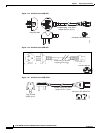
1-24
Cisco ASR 9001 and Cisco ASR 9001-S Routers Hardware Installation Guide
OL-26701-02
Chapter 1 Preparing for Installation
Cisco ASR 9001 Router Port Connection Guidelines
Auxiliary Port Signals
The RP Auxiliary (AUX) port is a RJ-45 interface for connecting a modem or other data communication
equipment (DCE) device (such as another router) to the RP. The AUX port supports hardware flow
control and modem control.
Table 1-4 lists the signals used on the Auxiliary port.
Management LAN Ports Connection Guidelines
The RP has two RJ45 media-dependent interface (MDI) Ethernet management LAN ports: MGT LAN 0
and MGT LAN 1 (see Figure 1-23).
These ports are used for IEEE 802.3 10BASE-T (10 Mbps), IEEE 802.3u 100BASE-TX (100 Mbps), or
1000BASE-T (1000 Mbps) Ethernet connections.
The transmission speed of the management LAN ports is not user-configurable. The transmission speed
is set through an auto-sensing scheme on the RP; the speed is determined by the network to which that
the Ethernet port is connected. The combined total input rate of both MGT LAN 0 and MGT LAN 1 is
about 12 Mbps.
Management port characteristics are:
• Maximum transmission unit (MTU) is fixed at 1514 and cannot be configured.
• Flow control is disabled and cannot be configured.
• Input unicast packets with an unknown destination address are filtered and dropped.
• Autonegotiation of port speed (10/100/1000) and duplex (full/half) is supported. Autonegotiation
cannot be disabled.
Table 1-5 lists the signals used on the Management LAN ports.
Table 1-4 RP AUX Port Signals
AUX Port Pin Signal Input/Output Description
1 RTS Output Request to send
2 DTR Output Data terminal ready
3 TxD Output Transmit data
4 GND — Signal ground
5 GND — Signal ground
6 RxD Input Receive data
7 DSR Input Data set ready
8 CTS Input Clear to send
Table 1-5 RP Management LAN Port Signals
MGT LAN Port Pin 10Base-T, 100Base-TX Signal 1000Base-T Signal
1 Transmit+ BI_DA+
2 Transmit– BI_DA–
3 Receive+ BI_DB+


















